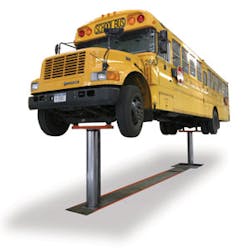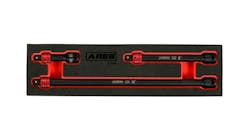Vehicle lifts are as essential to repair shops as screwdrivers, scan tools and socket sets. Dealers should be familiar with the wide range of capital equipment available for shops, not excluding lifts.
Depending on the type of shop, owners may look for in-ground or above-ground, and two-post or four-post lifts, based on the size of the shop, types of repairs and safety standards for the equipment they want or need.
TYPE OF REPAIR WORK
Shops often choose a particular lift model based on the types of repairs they do. Some styles available include two- and four-post styles, scissor lifts and hinged-surface lifts (think parallelogram).
“(Two-post lifts are) used primarily for under-car service and maintenance,” said John Rylee, marketing manager for Rotary Lift, “versus a four-post lift which is a drive-on lift, used for wheel alignments, wheel work, and can be used for some repair and service.”
For more underbody work, shops may opt for the four-post style.
“Surface-mount four-post-style lifts are the primary lift of many muffler, oil change and transmission shops or specialty shops that perform wheel alignment. It allows the vehicle to be driven onto two runways and lifted by its tires, exposing the underside of the vehicle,” said Jeff Kritzer, senior vice president of sales and marketing for BendPak/Ranger. “Open-front four-post designs have no front cross-beam, which provides free access to the front underside of the vehicle where alignment adjustments are made.”
Sometimes, larger shops will use moveable lifts. Because these lifts aren’t stationary, they can be used outside.
“Service centers often purchase portable lifts so they can locate the lift outside and do service in the parking lot in the event inside lifts are filled to capacity,” said Kritzer.
SIZE OF THE SHOP
In general, the bigger the shop, the more lifts necessary for smooth and fast operation. “Mom and pop” shops usually require just one or two lifts because of the smaller number of customers they serve.
In the past few decades, more small shops have transitioned from owning to renting the facilities where they service vehicles.
“Here’s a change that happened 20-30 years ago in garages. It used to be that my grandfather owned his own garage. He owned the garage, he owned the real estate and he owned the building,” said Steve Perlstein, sales manager for Mohawk Lifts. “But today, the tech who owns the garage is almost more likely to be a tenant in that shop. He rents.”
Perlstein said more shops tend to purchase above-ground lifts due to their rental agreements. This helps the shop avoid making changes or including additional installations to a building they don’t own. And once installed, the shop potentially runs into additional problems.
“If you do anything to improve a landlord’s property, that improvement becomes the property of the landlord,” said Perlstein.
Also called a “lease-hold improvement,” this means that, along with initial issues on installation, a shop renter won’t be able to remove the lift and take it with them to the next shop they purchase or rent from.
Along with rental agreement challenges, in-ground lifts tend to be more expensive and may become cumbersome for diagnosing and fixing equipment repairs.
An in-ground lift, however, has the main advantage of saving space in a shop.
Rylee explains that although an in-ground lift may be more expensive for a shop, techs are able to service more vehicles. Because the structure of the lift isn’t above ground, shops can usually fit an additional lift with the in-ground models.
“The footprint is narrower, so you can actually build in one more bay,” said Rylee. “That’s obviously a tremendous amount of additional revenue for the dealer.”
Some companies, like Rotary Lift, even offer help from private companies to assist with CAD drawings, in order to properly install lifting equipment.
Kritzer offered the following important criteria to keep in mind when assessing a shop for lifts:
• Lift location – Confirm there is space available in the shop before a purchase is made.
• Overhead obstructions – Measure the full dimensions in the location of where the lift will go, to ensure it won’t hit anything when fully extended.
• Defective concrete – Make sure the flooring isn’t cracked or damaged before installation.
• Level floor – Be sure the floor doesn’t have any severe grades or steep climbs.
STANDARDS, SAFETY AND PRICE
One issue with lifts includes the ANSI/OSHA standard for safety, as well as the Automotive Lift Institute’s ETL Certification Program. ALI approved the program, developed by an independent laboratory, to set lift standards for safety and performance.
“To consumers, the ETL mark is assurance that the product is compliant with safety standards, having been tested and certified by a third-party organization,” said Kritzer.
With American-made products, and original equipment parts in particular, there’s less of a risk problems will arise because of these standards. If they do, it’s usually easier to obtain the part or service necessary to fix the problem.
Smaller shops sometimes look to less expensive equipment in order to save money. But, this strategy could inadvertently cause long-term problems with faulty or poorly manufactured equipment.
“The value is sometimes a tough thing to sell, especially to the independent repair shop market. It’s a little easier to sell, like a dealership, because a dealer understands the value of good equipment,” said Rylee.
When a shop decides to purchase a lift strictly on price, it may be compromising quality of the product.
“(The shop) might have saved a couple hundred dollars the first day, but what’s it cost to not have an operational lift that day? All of a sudden, that becomes a very expensive lift,” said Perlstein.
By checking out the shops facilities, determining their line of repair work and educating customers on safety and standards, dealers can become a source of information and guidance for their customers when purchasing vehicle lifting equipment.


